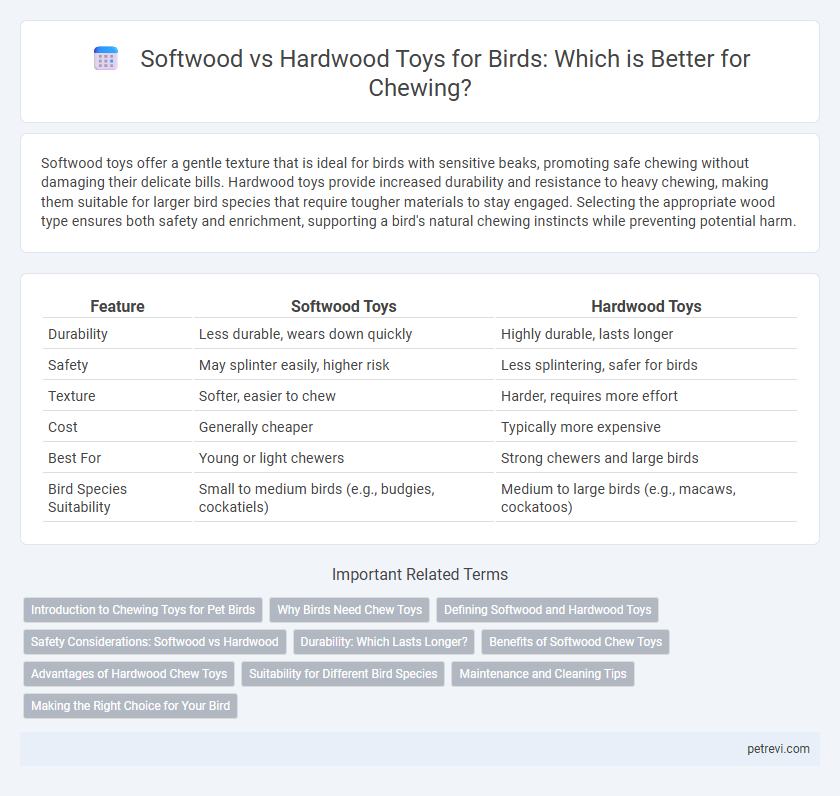Softwood toys offer a gentle texture that is ideal for birds with sensitive beaks, promoting safe chewing without damaging their delicate bills. Hardwood toys provide increased durability and resistance to heavy chewing, making them suitable for larger bird species that require tougher materials to stay engaged. Selecting the appropriate wood type ensures both safety and enrichment, supporting a bird's natural chewing instincts while preventing potential harm.
Table of Comparison
| Feature | Softwood Toys | Hardwood Toys |
|---|---|---|
| Durability | Less durable, wears down quickly | Highly durable, lasts longer |
| Safety | May splinter easily, higher risk | Less splintering, safer for birds |
| Texture | Softer, easier to chew | Harder, requires more effort |
| Cost | Generally cheaper | Typically more expensive |
| Best For | Young or light chewers | Strong chewers and large birds |
| Bird Species Suitability | Small to medium birds (e.g., budgies, cockatiels) | Medium to large birds (e.g., macaws, cockatoos) |
Introduction to Chewing Toys for Pet Birds
Softwood toys and hardwood toys serve distinct purposes in bird chewing enrichment, with softwoods like pine and balsa offering gentle surfaces that help maintain beak health without excessive wear. Hardwood toys made from maple, oak, or birch provide durable, long-lasting chewing options that challenge stronger beaks and promote mental stimulation. Selecting the appropriate wood type enhances safe chewing behavior and prevents ingestion of harmful splinters or toxins common in treated woods.
Why Birds Need Chew Toys
Birds require chew toys to maintain beak health and prevent boredom, stimulating natural behaviors essential for their well-being. Softwood toys, made from materials like balsa or pine, are gentle on sensitive bird beaks and ideal for species with weaker bites. Hardwood toys, such as those crafted from oak or maple, offer more durability and resistance, catering to birds with powerful chewing habits and helping to satisfy their instinctual need to gnaw.
Defining Softwood and Hardwood Toys
Softwood toys for birds are crafted from trees like pine, cedar, and fir, characterized by their lighter density and softer texture, making them ideal for gentle chewing and shredding activities. Hardwood toys originate from denser trees such as oak, maple, and walnut, offering durability and resistance to strong beaks, suitable for birds that require more robust chewing challenges. Selecting between softwood and hardwood toys depends on bird species and chewing strength, ensuring safety and mental stimulation.
Safety Considerations: Softwood vs Hardwood
Softwood toys for birds are generally softer and easier to chew, but they may harbor toxins or splinters if not properly treated, posing safety risks. Hardwood toys, made from denser and less porous materials like maple or oak, are typically safer and more durable, reducing the likelihood of ingestion of harmful particles. Selecting untreated, bird-safe wood types ensures a safer chewing experience, minimizing health hazards associated with toxic finishes or brittle wood.
Durability: Which Lasts Longer?
Hardwood toys for bird chewing generally offer greater durability than softwood toys due to the denser fiber structure that resists wear and breakage. Birds that engage in vigorous chewing will find hardwood toys last longer and maintain structural integrity, providing prolonged enrichment. In contrast, softwood toys, while often more affordable and lightweight, tend to wear down faster and require more frequent replacement.
Benefits of Softwood Chew Toys
Softwood chew toys for birds offer a lightweight and easily manageable texture that encourages natural chewing behaviors while reducing the risk of dental damage. These toys often contain natural oils and resins that can provide mild antimicrobial properties, promoting oral health. Softwood's softer fibers are gentler on a bird's beak and minimize splintering hazards compared to hardwood alternatives.
Advantages of Hardwood Chew Toys
Hardwood chew toys for birds offer superior durability and resistance to splintering compared to softwood options, making them safer and longer-lasting for aggressive chewers. Dense woods like maple, oak, and apple are non-toxic and provide natural resistance to wear, promoting healthy beak maintenance and preventing accidental ingestion of harmful debris. Their hardness helps satisfy birds' instinctual need to chew while supporting dental health through consistent, controlled wear.
Suitability for Different Bird Species
Softwood toys such as pine and balsa are ideal for smaller bird species like budgerigars and cockatiels due to their gentle texture that prevents beak damage. Hardwood toys, made from maple, oak, or walnut, provide the necessary durability and resistance for larger birds like African greys and macaws, supporting their stronger chewing habits. Selecting the appropriate wood type ensures safe and stimulating enrichment tailored to the bird's size and chewing strength.
Maintenance and Cleaning Tips
Softwood toys for birds require frequent inspection due to their tendency to wear down quickly, making regular cleaning essential to prevent bacteria buildup. Hardwood toys offer greater durability, reducing the risk of splinters and allowing easier maintenance through simple wiping or soaking in bird-safe disinfectants. Both types should be cleaned weekly, with thorough drying to maintain hygiene and prevent mold growth, ensuring a safe chewing experience for birds.
Making the Right Choice for Your Bird
Softwood toys provide softer textures ideal for gentle chewers, reducing the risk of damaging sensitive beaks, while hardwood toys offer durability and challenge for stronger birds requiring more intensive gnawing. Selecting the right toy depends on your bird's chewing habits, beak strength, and safety, ensuring materials are non-toxic and free from harmful finishes. Prioritize toys made from bird-safe woods like pine for softwood options and maple or birch for hardwood to promote healthy chewing behavior and mental stimulation.
Softwood toys vs Hardwood toys for Bird chewing Infographic

 petrevi.com
petrevi.com